Pioneer 10 plunges into the asteroid belt
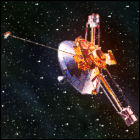 En route to becoming the first human-made spacecraft to visit Jupiter, NASA’s Pioneer 10 also becomes the first human-made spacecraft to enter the asteroid belt between the orbits of Mars and Jupiter. Whether or not the spacecraft will survive this crossing is indeed one of the mission’s major experiments, and is a topic of active debate between scientists with differing views of how densely populated the asteroid belt may be. The spacecraft will survive the crossing without incident.
En route to becoming the first human-made spacecraft to visit Jupiter, NASA’s Pioneer 10 also becomes the first human-made spacecraft to enter the asteroid belt between the orbits of Mars and Jupiter. Whether or not the spacecraft will survive this crossing is indeed one of the mission’s major experiments, and is a topic of active debate between scientists with differing views of how densely populated the asteroid belt may be. The spacecraft will survive the crossing without incident.

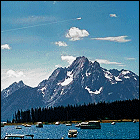 In the broad daylight of mid-afternoon, an asteroid measuring somewhere between 10 and 50 feet in diameter plows through Earth’s atmosphere over North America, creating a long-tailed fireball across the sky. Undetected before its close pass – only 35 miles from Earth’s surface – asteroid US19720810 skips off of the atmosphere and back into space, having lost half of its mass to the frictional heating of plummeting through the atmosphere. The spectacle lasts only a couple of minutes, and US19720810 will make another pass by the Earth in
In the broad daylight of mid-afternoon, an asteroid measuring somewhere between 10 and 50 feet in diameter plows through Earth’s atmosphere over North America, creating a long-tailed fireball across the sky. Undetected before its close pass – only 35 miles from Earth’s surface – asteroid US19720810 skips off of the atmosphere and back into space, having lost half of its mass to the frictional heating of plummeting through the atmosphere. The spectacle lasts only a couple of minutes, and US19720810 will make another pass by the Earth in 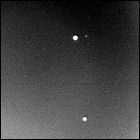 Voyager 1 emerges unharmed from what is considered the outer limit of the asteroid belt between Mars and Jupiter, having entered this 223,000,000-mile-wide zone of space in December 1977. Voyager 2 is expected to emerge similarly unscathed in late October 1978. NASA’s Pioneer 10 and 11 spacecraft had already demonstrated, in the early 1970s, that passage through the asteroid belt without mission-jeopardizing damage is possible. Both spacecraft are already imaging Jupiter from a distance of less than 180,000,000 miles, now meeting or exceeding the resolution of the best photos of Jupiter taken from Earth-based telescopes.
Voyager 1 emerges unharmed from what is considered the outer limit of the asteroid belt between Mars and Jupiter, having entered this 223,000,000-mile-wide zone of space in December 1977. Voyager 2 is expected to emerge similarly unscathed in late October 1978. NASA’s Pioneer 10 and 11 spacecraft had already demonstrated, in the early 1970s, that passage through the asteroid belt without mission-jeopardizing damage is possible. Both spacecraft are already imaging Jupiter from a distance of less than 180,000,000 miles, now meeting or exceeding the resolution of the best photos of Jupiter taken from Earth-based telescopes.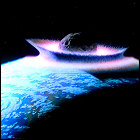 In the journal Science, in an article titled “Extraterrestrial Cause for the Cretaceous-Tertiary Extinction”, Nobel-Prize-winning physicist Luis Alvarez and his son, geologist Walter Alvarez, propose their theory that the 110-mile-wide Chicxulub Crater discovered in the past few decades on the northern tip of the Yucatan Peninsula in Mexico is evidence of a large asteroid collision with Earth, resulting in the widespread death of the dinosaurs 65 million years before the modern day. A contentious peer review of the published theory follows, with many opposing theories proposed, though the Chicxulub hypothesis is eventually accepted as the “smoking gun” that killed the dinosaurs (the theory of an asteroid collision with Earth causing the extinction had been in circulation since the 1950s; the Alvarez theory is the first to point to a specific geological feature as evidence).
In the journal Science, in an article titled “Extraterrestrial Cause for the Cretaceous-Tertiary Extinction”, Nobel-Prize-winning physicist Luis Alvarez and his son, geologist Walter Alvarez, propose their theory that the 110-mile-wide Chicxulub Crater discovered in the past few decades on the northern tip of the Yucatan Peninsula in Mexico is evidence of a large asteroid collision with Earth, resulting in the widespread death of the dinosaurs 65 million years before the modern day. A contentious peer review of the published theory follows, with many opposing theories proposed, though the Chicxulub hypothesis is eventually accepted as the “smoking gun” that killed the dinosaurs (the theory of an asteroid collision with Earth causing the extinction had been in circulation since the 1950s; the Alvarez theory is the first to point to a specific geological feature as evidence).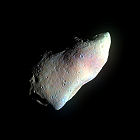 NASA/JPL’s Galileo space probe, looping repeatedly through the inner solar system to gain a speed boost from a series of gravity assists from Earth and Venus, passes the asteroid 951 Gaspra, the first human-made spacecraft to visit such a body. Where humanity’s previous knowledge of asteroids was limited at best, Galileo’s findings are startling, with photos showing a small rocky body pummeled by ancient impacts, almost to the point of shattering it. Also discovered is a magnetic field generated by the core of the asteroid itself, something planetary scientists did not expect to find at all. Galileo will loop back toward Earth, picking up a critical speed boost to Jupiter from one last flyby of its home planet.
NASA/JPL’s Galileo space probe, looping repeatedly through the inner solar system to gain a speed boost from a series of gravity assists from Earth and Venus, passes the asteroid 951 Gaspra, the first human-made spacecraft to visit such a body. Where humanity’s previous knowledge of asteroids was limited at best, Galileo’s findings are startling, with photos showing a small rocky body pummeled by ancient impacts, almost to the point of shattering it. Also discovered is a magnetic field generated by the core of the asteroid itself, something planetary scientists did not expect to find at all. Galileo will loop back toward Earth, picking up a critical speed boost to Jupiter from one last flyby of its home planet.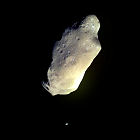 Bound for Jupiter, the NASA/JPL unmanned space probe Galileo swings past the asteroid Ida, discovering – for the first time – an asteroid with its own satellite, a tiny body orbiting Ida. The satellite is later named Dactyl. This is only the second asteroid to be visited by a spacecraft from Earth, and Ida also marks Galileo’s last visit to a body in the solar system before a two-year cruise toward Jupiter.
Bound for Jupiter, the NASA/JPL unmanned space probe Galileo swings past the asteroid Ida, discovering – for the first time – an asteroid with its own satellite, a tiny body orbiting Ida. The satellite is later named Dactyl. This is only the second asteroid to be visited by a spacecraft from Earth, and Ida also marks Galileo’s last visit to a body in the solar system before a two-year cruise toward Jupiter.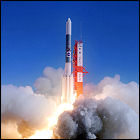 The NEAR (Near Earth Asteroid Rendezvous) unmanned spacecraft, built and flown for NASA by John Hopkins University’s Applied Physics Lab, lifts off from Cape Canaveral on a mission to orbit and study asteroid 433 Eros, a target it won’t reach until 1998 at the earliest; it will fly by another asteroid in 1997. Other trajectories under consideration during mission planning included a combination of several asteroids and comets, before the limitations of NEAR’s chemical propulsion system forced those plans to be scaled back. (A more ambitious multi-asteroid mission, Dawn, will be launched in the 21st century.) NEAR will become the first human-made spacecraft to land on an asteroid.
The NEAR (Near Earth Asteroid Rendezvous) unmanned spacecraft, built and flown for NASA by John Hopkins University’s Applied Physics Lab, lifts off from Cape Canaveral on a mission to orbit and study asteroid 433 Eros, a target it won’t reach until 1998 at the earliest; it will fly by another asteroid in 1997. Other trajectories under consideration during mission planning included a combination of several asteroids and comets, before the limitations of NEAR’s chemical propulsion system forced those plans to be scaled back. (A more ambitious multi-asteroid mission, Dawn, will be launched in the 21st century.) NEAR will become the first human-made spacecraft to land on an asteroid.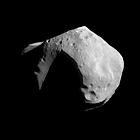 NASA’s NEAR (Near Earth Asteroid Rendezvous) unmanned spacecraft closes to within 750 miles of its first target, asteroid 253 Mathilde. Taking over 500 pictures of the asteroid and determining its mass and dimensions (roughly 31 miles in diameter). At the time of this flyby, Mathilde is the largest asteroid to be explored by a spacecraft. Discovered in 1885, Mathilde takes four years to orbit the sun within the main asteroid belt between Mars and Jupiter. NEAR Shoemaker moves on to its next destination, asteroid 433 Eros, which it is expected to reach in 1998.
NASA’s NEAR (Near Earth Asteroid Rendezvous) unmanned spacecraft closes to within 750 miles of its first target, asteroid 253 Mathilde. Taking over 500 pictures of the asteroid and determining its mass and dimensions (roughly 31 miles in diameter). At the time of this flyby, Mathilde is the largest asteroid to be explored by a spacecraft. Discovered in 1885, Mathilde takes four years to orbit the sun within the main asteroid belt between Mars and Jupiter. NEAR Shoemaker moves on to its next destination, asteroid 433 Eros, which it is expected to reach in 1998.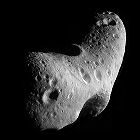 NASA’s unmanned NEAR (Near Earth Asteroid Rendezvous) unmanned space probe fails to fire its thrusters for a critical engine burn to keep it aimed at asteroid 433 Eros. The vehicle instead goes into an automatic safe mode and enters a tumble that drains both its batteries and its fuel supply to dangerously low levels, and it is out of contact with Earth for over a day. As a result, NEAR merely flies past Eros at a distance of almost 2400 miles, leaving ground controllers to devise a strategy to re-aim NEAR so it can catch up to and try once again to orbit the asteroid (the primary objective of its mission). This maneuver will take a year to complete.
NASA’s unmanned NEAR (Near Earth Asteroid Rendezvous) unmanned space probe fails to fire its thrusters for a critical engine burn to keep it aimed at asteroid 433 Eros. The vehicle instead goes into an automatic safe mode and enters a tumble that drains both its batteries and its fuel supply to dangerously low levels, and it is out of contact with Earth for over a day. As a result, NEAR merely flies past Eros at a distance of almost 2400 miles, leaving ground controllers to devise a strategy to re-aim NEAR so it can catch up to and try once again to orbit the asteroid (the primary objective of its mission). This maneuver will take a year to complete.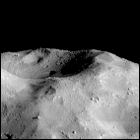 After orbiting the sun behind asteroid 433 Eros for a year since a failed thruster burn almost ended its mission, unmanned space probe NEAR (Near Earth Asteroid Rendezvous) fires its engines successfully, slowing itself to fall into orbit around Eros. During the weeks leading up to the orbital insertion maneuver, NEAR observed the space around Eros to ensure that no satellites existed with which it might collide. NEAR’s close study of Eros officially begins, and further maneuvers bring it into an ever-closer orbit around the asteroid.
After orbiting the sun behind asteroid 433 Eros for a year since a failed thruster burn almost ended its mission, unmanned space probe NEAR (Near Earth Asteroid Rendezvous) fires its engines successfully, slowing itself to fall into orbit around Eros. During the weeks leading up to the orbital insertion maneuver, NEAR observed the space around Eros to ensure that no satellites existed with which it might collide. NEAR’s close study of Eros officially begins, and further maneuvers bring it into an ever-closer orbit around the asteroid.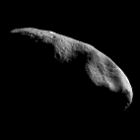 NASA’s NEAR (Near Earth Asteroid Rendezvous) unmanned spacecraft is officially renamed NEAR-Shoemaker, honoring Eugene Shoemaker, discoverer of multiple asteroids and comets, who died in 1997. Shoemaker had also put his geology skills to use in training Apollo astronauts after a medical diagnosis prevented him from joining the astronaut corps himself. NEAR-Shoemaker continues to orbit asteroid 433 Eros.
NASA’s NEAR (Near Earth Asteroid Rendezvous) unmanned spacecraft is officially renamed NEAR-Shoemaker, honoring Eugene Shoemaker, discoverer of multiple asteroids and comets, who died in 1997. Shoemaker had also put his geology skills to use in training Apollo astronauts after a medical diagnosis prevented him from joining the astronaut corps himself. NEAR-Shoemaker continues to orbit asteroid 433 Eros.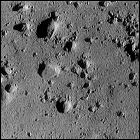 NASA’s NEAR-Shoemaker unmanned spacecraft gently touches down on the surface of asteroid 433 Eros, the first human-made space vehicle to land on such a body. Ground controllers are surprised to discover that NEAR-Shoemaker survives the landing, which was originally meant to end the mission; a two-week mission extension allows scientists to get readings from instruments that are now mere inches from Eros’ surface.
NASA’s NEAR-Shoemaker unmanned spacecraft gently touches down on the surface of asteroid 433 Eros, the first human-made space vehicle to land on such a body. Ground controllers are surprised to discover that NEAR-Shoemaker survives the landing, which was originally meant to end the mission; a two-week mission extension allows scientists to get readings from instruments that are now mere inches from Eros’ surface.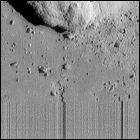 NASA’s NEAR-Shoemaker unmanned spacecraft, still on the surface of asteroid 433 Eros, sends its final signals to Earth before shutting down. Launched in 1996, NEAR-Shoemaker swung by asteroid 253 Mathilde before making its way to Eros via an Earth gravity assist maneuver. It orbited Eros for a year, having started its operations in close proximity to the asteroid a year later due to a technical problem in 1998 that nearly destroyed the space probe. Future asteroid missions such as Hayabusa and Dawn will refine the science of traveling to and studying asteroids.
NASA’s NEAR-Shoemaker unmanned spacecraft, still on the surface of asteroid 433 Eros, sends its final signals to Earth before shutting down. Launched in 1996, NEAR-Shoemaker swung by asteroid 253 Mathilde before making its way to Eros via an Earth gravity assist maneuver. It orbited Eros for a year, having started its operations in close proximity to the asteroid a year later due to a technical problem in 1998 that nearly destroyed the space probe. Future asteroid missions such as Hayabusa and Dawn will refine the science of traveling to and studying asteroids.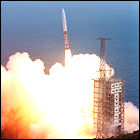 Japan’s Institute of Space and Astronautical Science (ISAS), launches the unmanned Hayabusa space probe on a mission to gather material from asteroid 25143 Itokawa. Intended to reach Itokawa in two years, and then return the asteroid samples to Earth in 2010, Hayabusa will also attempt to drop a small rover on Itokawa’s surface and will test an ion engine propulsion system. The name “Hayabusa” – translating to “peregrine falcon” – is only bestowed upon the spacecraft once it reaches space; prior to that, Hayabusa is known by its engineering designation, MUSES-C. A few months after Hayabusa’s launch, ISAS itself is renamed JAXA (the Japanese Aerospace Exploration Agency).
Japan’s Institute of Space and Astronautical Science (ISAS), launches the unmanned Hayabusa space probe on a mission to gather material from asteroid 25143 Itokawa. Intended to reach Itokawa in two years, and then return the asteroid samples to Earth in 2010, Hayabusa will also attempt to drop a small rover on Itokawa’s surface and will test an ion engine propulsion system. The name “Hayabusa” – translating to “peregrine falcon” – is only bestowed upon the spacecraft once it reaches space; prior to that, Hayabusa is known by its engineering designation, MUSES-C. A few months after Hayabusa’s launch, ISAS itself is renamed JAXA (the Japanese Aerospace Exploration Agency).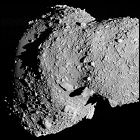 The Japanese unmanned space probe Hayabusa arrives at its destination, asteroid 25143 Itokawa, from which it will gather a sample of material for return to Earth and attempt to deploy a mini-rover. Hayabusa settles into an orbit around the sun parallel to Itokawa, rather than orbiting the asteroid itself, and maintains an initial distance of roughly 12 miles.
The Japanese unmanned space probe Hayabusa arrives at its destination, asteroid 25143 Itokawa, from which it will gather a sample of material for return to Earth and attempt to deploy a mini-rover. Hayabusa settles into an orbit around the sun parallel to Itokawa, rather than orbiting the asteroid itself, and maintains an initial distance of roughly 12 miles.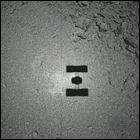 The first attempt to maneuver the unmanned space probe Hayabusa close enough to scoop up a sample of material from the surface of asteroid 25143 Itokawa is aborted by ground controllers at the Japanese space agency, JAXA. The spacecraft’s navigational system finds it difficult to maintain a precise lock on the elongated asteroid, so its automatic safety systems abort the approach to preserve Hayabusa intact. Another attempt to bring Hayabusa close enough to gather material from Itokawa’s surface will be made a week later.
The first attempt to maneuver the unmanned space probe Hayabusa close enough to scoop up a sample of material from the surface of asteroid 25143 Itokawa is aborted by ground controllers at the Japanese space agency, JAXA. The spacecraft’s navigational system finds it difficult to maintain a precise lock on the elongated asteroid, so its automatic safety systems abort the approach to preserve Hayabusa intact. Another attempt to bring Hayabusa close enough to gather material from Itokawa’s surface will be made a week later.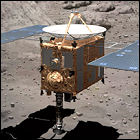 A second attempt is made by the Japanese Aerospace Exploration Agency to bring its unmanned space probe, Hayabusa, close enough to gather a sample of surface material from asteroid 25143 Itokawa. It attempts to deploy a mini-rover called Minerva to explore Itokawa from the surface, but a glitch results in a trajectory that leaves Minerva tumbling into space, never to reach Itokawa. Hayabusa lands on Itokawa’s surface itself, though mission controllers don’t realize this for several more days. Contact is lost with Hayabusa for a short while, and when it is regained, the vehicle has left the surface and gone into safe mode.
A second attempt is made by the Japanese Aerospace Exploration Agency to bring its unmanned space probe, Hayabusa, close enough to gather a sample of surface material from asteroid 25143 Itokawa. It attempts to deploy a mini-rover called Minerva to explore Itokawa from the surface, but a glitch results in a trajectory that leaves Minerva tumbling into space, never to reach Itokawa. Hayabusa lands on Itokawa’s surface itself, though mission controllers don’t realize this for several more days. Contact is lost with Hayabusa for a short while, and when it is regained, the vehicle has left the surface and gone into safe mode.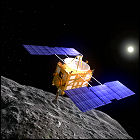 JAXA’s unmanned Hayabusa spacecraft fires its ion engines to depart asteroid 25143 Itokawa, embarking on a five-year trek back to Earth to return surface samples it obtained of the asteroid. Hayabusa has experienced numerous technical glitches, and continues to experience further problems, including a total loss of contact with Earth for several weeks. Only two out of the vehicle’s four ion engines are still functional, and its battery system is only partially reliable, but it is carrying its precious cargo of the first sample material from an asteroid back to Earth.
JAXA’s unmanned Hayabusa spacecraft fires its ion engines to depart asteroid 25143 Itokawa, embarking on a five-year trek back to Earth to return surface samples it obtained of the asteroid. Hayabusa has experienced numerous technical glitches, and continues to experience further problems, including a total loss of contact with Earth for several weeks. Only two out of the vehicle’s four ion engines are still functional, and its battery system is only partially reliable, but it is carrying its precious cargo of the first sample material from an asteroid back to Earth.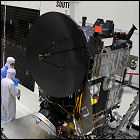 Having been “on hold” since October 2005 pending an audit of technical and managerial issues related to the mission, NASA formally cancels the Dawn unmanned mission to the asteroid belt. The spacecraft had been intended to lift off in 2006, using an ion propulsion system to visit, orbit, and map not one, but two, of the largest bodies in the asteroid belt between Mars and Jupiter, in the following decade. The mission is cancelled when NASA auditors find unresolved technical issues and project a budget overrun of 20%. Planners and managers for the Dawn mission plan to appeal NASA’s decision.
Having been “on hold” since October 2005 pending an audit of technical and managerial issues related to the mission, NASA formally cancels the Dawn unmanned mission to the asteroid belt. The spacecraft had been intended to lift off in 2006, using an ion propulsion system to visit, orbit, and map not one, but two, of the largest bodies in the asteroid belt between Mars and Jupiter, in the following decade. The mission is cancelled when NASA auditors find unresolved technical issues and project a budget overrun of 20%. Planners and managers for the Dawn mission plan to appeal NASA’s decision.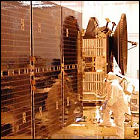 NASA reverses a decision made earlier in the month to cancel the asteroid-hopping Dawn mission, following appeals and assurances from the mission managers. Intended to use ion propulsion to visit to of the asteroid belt’s largest bodies, Dawn’s cancellation does have the effect of sliding the mission from a 2006 launch to a 2007 launch. The budget for the mission is expanded from $373,000,000 to $446,000,000, and arrival at its first target, the large asteroid Vesta, is still scheduled for 2011.
NASA reverses a decision made earlier in the month to cancel the asteroid-hopping Dawn mission, following appeals and assurances from the mission managers. Intended to use ion propulsion to visit to of the asteroid belt’s largest bodies, Dawn’s cancellation does have the effect of sliding the mission from a 2006 launch to a 2007 launch. The budget for the mission is expanded from $373,000,000 to $446,000,000, and arrival at its first target, the large asteroid Vesta, is still scheduled for 2011.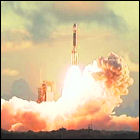 NASA launches the unmanned Dawn spacecraft, a vehicle designed to explore the two largest bodies in the asteroid belt between Mars and Jupiter. Dawn will also test a new charged ion propulsion system designed to improve on the performance of traditional chemical propellants (though its fine-tuning reaction control system will still use small engines powered by “rocket fuel”). Dawn is intended to visit and orbit the asteroid Vesta in 2011, which it will then depart after mapping to explore Ceres in 2015.
NASA launches the unmanned Dawn spacecraft, a vehicle designed to explore the two largest bodies in the asteroid belt between Mars and Jupiter. Dawn will also test a new charged ion propulsion system designed to improve on the performance of traditional chemical propellants (though its fine-tuning reaction control system will still use small engines powered by “rocket fuel”). Dawn is intended to visit and orbit the asteroid Vesta in 2011, which it will then depart after mapping to explore Ceres in 2015. Astronomers put the red planet on red alert after predicting 1-in-75 odds for an asteroid to collide with Mars on or near January 30th. The asteroid, discovered in November 2007, is on a trajectory that poses no threat to Earth but has better-than-usual odds of packing quite a wallop for Mars. The impact, if it does happen, could take place on the equator, near the Opportunity rover’s stomping (or, perhaps, roving) grounds, though NASA says it would pose no risk to Opportunity. A crater as large as Arizona’s Meteor Crater could be carved out of the Martian surface by any direct hit that does happen. Scientists prepare to watch the event with keen interest, as this event would be potentially cataclysmic if Earth was in danger, but provides a once-in-a-lifetime opportunity for observation on Mars.
Astronomers put the red planet on red alert after predicting 1-in-75 odds for an asteroid to collide with Mars on or near January 30th. The asteroid, discovered in November 2007, is on a trajectory that poses no threat to Earth but has better-than-usual odds of packing quite a wallop for Mars. The impact, if it does happen, could take place on the equator, near the Opportunity rover’s stomping (or, perhaps, roving) grounds, though NASA says it would pose no risk to Opportunity. A crater as large as Arizona’s Meteor Crater could be carved out of the Martian surface by any direct hit that does happen. Scientists prepare to watch the event with keen interest, as this event would be potentially cataclysmic if Earth was in danger, but provides a once-in-a-lifetime opportunity for observation on Mars.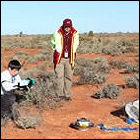 Japan’s Hayabusa unmanned space probe releases a re-entry capsule containing samples of surface material it gathered from asteroid 25143 Itokawa in 2005. The capsule survives a punishing 25G re-entry and is recovered from the Australian outback, as planned, while Hayabusa itself burns up in Earth’s atmosphere. The sample payload – approximately 1500 grains averaging 10 micrometers in diameter – reveals that Itokawa has a composition virtually identical to a chondrite meteorite. A significant achievement in the history of the Japanese space program, the Hayabusa mission inspires no fewer than three movies, and a sequel of its own: the Hayabusa-2 space probe, approved in August 2010 and scheduled for launch in 2014.
Japan’s Hayabusa unmanned space probe releases a re-entry capsule containing samples of surface material it gathered from asteroid 25143 Itokawa in 2005. The capsule survives a punishing 25G re-entry and is recovered from the Australian outback, as planned, while Hayabusa itself burns up in Earth’s atmosphere. The sample payload – approximately 1500 grains averaging 10 micrometers in diameter – reveals that Itokawa has a composition virtually identical to a chondrite meteorite. A significant achievement in the history of the Japanese space program, the Hayabusa mission inspires no fewer than three movies, and a sequel of its own: the Hayabusa-2 space probe, approved in August 2010 and scheduled for launch in 2014.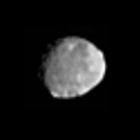 From a distance of 117,000 miles, NASA’s Dawn unmanned space probe captures the best picture yet of the asteroid Vesta, one of the two largest bodies in the solar system’s main asteroid belt between Mars and Jupiter. Launched in 2007, Dawn is scheduled to orbit and map Vesta before moving on to the asteroid belt’s largest resident, Ceres, in 2015. Mission scientists hope that the two asteroids – remnants of what may be an unformed or destroyed rocky planet beyond Mars’ orbit – will yield clues about the formation of the solar system.
From a distance of 117,000 miles, NASA’s Dawn unmanned space probe captures the best picture yet of the asteroid Vesta, one of the two largest bodies in the solar system’s main asteroid belt between Mars and Jupiter. Launched in 2007, Dawn is scheduled to orbit and map Vesta before moving on to the asteroid belt’s largest resident, Ceres, in 2015. Mission scientists hope that the two asteroids – remnants of what may be an unformed or destroyed rocky planet beyond Mars’ orbit – will yield clues about the formation of the solar system.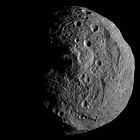 Launched in 2007, NASA’s unmanned space probe Dawn enters orbit of Vesta, one of the largest bodies in the main asteroid belt between Mars and Jupiter. Over time, the mission plan calls for Dawn to spiral down to lower orbits to explore and map Vesta from orbit, trying to determine what secrets the large asteroid has about the earliest days of the solar system. If all goes well, Dawn will remain at Vesta until 2012, and will depart to explore another asteroid, Ceres, arriving there in 2015.
Launched in 2007, NASA’s unmanned space probe Dawn enters orbit of Vesta, one of the largest bodies in the main asteroid belt between Mars and Jupiter. Over time, the mission plan calls for Dawn to spiral down to lower orbits to explore and map Vesta from orbit, trying to determine what secrets the large asteroid has about the earliest days of the solar system. If all goes well, Dawn will remain at Vesta until 2012, and will depart to explore another asteroid, Ceres, arriving there in 2015.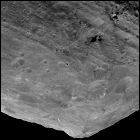 NASA’s unmanned Dawn spacecraft, having completed its high-altitude mapping of the asteroid Vesta, drops to a lower altitude for more detailed mapping of Vesta’s surface. On average, its new orbit will allow Dawn to circle Vesta at an altitude of 130 miles, down from its previous 430-mile-high altitude. Dawn is imaging Vesta stereographically, allowing for precise measurements of surface features and the asteroid’s overall shape. In 2012, Dawn is scheduled to fire its ion thruster again, breaking orbit and leaving Vesta for a three-year cruise to the largest body in the asteroid belt, Ceres, arriving in 2015.
NASA’s unmanned Dawn spacecraft, having completed its high-altitude mapping of the asteroid Vesta, drops to a lower altitude for more detailed mapping of Vesta’s surface. On average, its new orbit will allow Dawn to circle Vesta at an altitude of 130 miles, down from its previous 430-mile-high altitude. Dawn is imaging Vesta stereographically, allowing for precise measurements of surface features and the asteroid’s overall shape. In 2012, Dawn is scheduled to fire its ion thruster again, breaking orbit and leaving Vesta for a three-year cruise to the largest body in the asteroid belt, Ceres, arriving in 2015.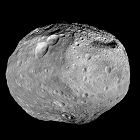 NASA’s Dawn unmanned space probe fires up its ion propulsion system, breaking its orbit around the large asteroid Vesta. Having orbited and mapped Vesta since 2011, Dawn must now survive a nearly-three-year trip through the main asteroid belt to reach the largest body in that region, Ceres. Successful arrival at Ceres, planned for 2015, would make Dawn the first unmanned spacecraft to have orbited two bodies in the solar system.
NASA’s Dawn unmanned space probe fires up its ion propulsion system, breaking its orbit around the large asteroid Vesta. Having orbited and mapped Vesta since 2011, Dawn must now survive a nearly-three-year trip through the main asteroid belt to reach the largest body in that region, Ceres. Successful arrival at Ceres, planned for 2015, would make Dawn the first unmanned spacecraft to have orbited two bodies in the solar system.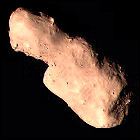 Originally launched by China to orbit the moon in 2010, and later parked at a LaGrange point beyond the moon’s orbit, the unmanned Chang’e 2 space probe flies by asteroid 4179 Toutatis at a distance of under two miles, capturing the first close-up images of the asteroid as it passes Earth almost half a million miles away. Though 4179 Toutatis has been imaged by ground-based radar on several occasions during its semi-frequent visits to the inner solar system, this is the first space probe to visit it at close range. As of this encounter, Chang’e 2 is the most distant Chinese spacecraft from Earth.
Originally launched by China to orbit the moon in 2010, and later parked at a LaGrange point beyond the moon’s orbit, the unmanned Chang’e 2 space probe flies by asteroid 4179 Toutatis at a distance of under two miles, capturing the first close-up images of the asteroid as it passes Earth almost half a million miles away. Though 4179 Toutatis has been imaged by ground-based radar on several occasions during its semi-frequent visits to the inner solar system, this is the first space probe to visit it at close range. As of this encounter, Chang’e 2 is the most distant Chinese spacecraft from Earth. One of the closest asteroid encounters since the beginning of intensive asteroid tracking, asteroid 2012 DA14 swings past Earth at a distance of only 17,200 miles – putting it closer to Earth than most weather and communcations satellites in geosynchronous orbit. Despite this, the asteroid is well outside the orbit of such low-Earth-orbit structures as the International Space Station. Discovered in February 2012, 2012 DA14 has a diameter of approximately 150 feet and is moving at a speed of over 17,000 miles per hour. 2012 DA14’s next closest approach will take place in 2046, but it will not make another passage this close until 2110. The asteroid is unrelated to a meteor airburst event earlier the same day over Russia.
One of the closest asteroid encounters since the beginning of intensive asteroid tracking, asteroid 2012 DA14 swings past Earth at a distance of only 17,200 miles – putting it closer to Earth than most weather and communcations satellites in geosynchronous orbit. Despite this, the asteroid is well outside the orbit of such low-Earth-orbit structures as the International Space Station. Discovered in February 2012, 2012 DA14 has a diameter of approximately 150 feet and is moving at a speed of over 17,000 miles per hour. 2012 DA14’s next closest approach will take place in 2046, but it will not make another passage this close until 2110. The asteroid is unrelated to a meteor airburst event earlier the same day over Russia.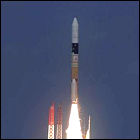 The Japanese Aerospace Exploration Agency (JAXA) launches the Hayabusa-2 unmanned space probe, intended to study and sample asteroid 162173 Ryugu in 2018. Mission plans call for the ion-engine-powered Hayabusa-2 to remain at Ryugu for a year before returning to Earth with its sample. Hayabusa-2 also carries a European-built lander and an explosive penetrator to expose the asteroid’s subsurface material (using the same principle as the Deep Impact mission to Comet Tempel 1 in 2005.
The Japanese Aerospace Exploration Agency (JAXA) launches the Hayabusa-2 unmanned space probe, intended to study and sample asteroid 162173 Ryugu in 2018. Mission plans call for the ion-engine-powered Hayabusa-2 to remain at Ryugu for a year before returning to Earth with its sample. Hayabusa-2 also carries a European-built lander and an explosive penetrator to expose the asteroid’s subsurface material (using the same principle as the Deep Impact mission to Comet Tempel 1 in 2005.